Contents
- 1. The name according to the birth and the name for worldly activities
- 2. Sankalpa and the ritual Sankalpa for the Naming ceremony (Namakaran)
- 3. The ritual of Naming ceremony
- 4. Selection of the name
- 4 A. Importance of the Name of a Deity and the Naming ceremony ritual of a child
- 4 B. The name should be selected using the following rules
- 4 C. The last letter should be prolonged or should have the soft aspirate (visarg; Namaha is the visarg)
- 4 D. A boy’s name should consist of two or four letters
- 4 E. The first letter in a girl’s name should not be double
- 4 F. If one desires that the child become famous, then its name should consist of two letters.
- 4 G. Naming of a child as per the desires of excellence in the child
- 4 H. Bharatiya psychology emphatically states that the name has great impact on the mind, worldly interactions and life of an individual.
- 5. Categories of names
- 6. The name according to the star sign : This naming can be done in two ways.
- 7. Other names
- 8. The ritual of four types of naming
- 9. The naming of a daughter
Namakaran (Naming ceremony) is done to identify the child and to liberate the child from the sins generated from the ovum and the foetus, for longevity, for fulfilment of all material pursuits and to create love for God in it.
1. The name according to the
birth and the name for worldly activities
When performing the ritual of sandhya, the child needs to pronounce its birth name. It is also used when performing any ritual and is required for making the horoscope. For other worldly purposes, a worldly name is used. – H.H. Pande Maharaj, Sanatan Ashram, Devad, Panvel, Maharashtra.
2. Sankalpa and the ritual Sankalpa for the Naming ceremony (Namakaran)
The sankalpa expressed on that day is – ‘I am performing this sanskar of Naming ceremony for my child, to wipe off any sin generated from the ovum and foetus, for longevity, for fulfilment of all material pursuits and to acquire the grace of Parameshwar for it. I am performing Shri Ganapatipujan, Punyahavachan, Matrukapujan and Nandishraddha, which are incorporated in it’.
3. The ritual of Naming ceremony
3 A. Science underlying sanskar of Naming ceremony
According to the scriptures, this sanskar should be performed on the boy or girl on the eleventh, twelfth or thirteenth day after birth. On these days, the mother is pure enough to perform the Naming ceremony. When performing this sanskar Shri Ganapatipujan, Punyahavachan, Matrukapujan, Nandishraddha and a fire sacrifice are performed. Some rice is placed in a bronze plate, and the name of the child is engraved on it.
(Note : The mother is pure for performing various rituals like Jatakarma, Naming ceremony or a Shanti for unfavourable asterisms or yog existing at the time of the child’s birth; however, according to the scriptures, for other rituals, she becomes pure to perform them only after 30 days of the birth of a son and 40 days after the birth of a daughter.)
3 B. Customs of Naming ceremony
There are various methods of performing Naming ceremony. By tradition, Naming ceremony is performed on the 12th day for a son and 11th day for a daughter. However, in some families, it is performed after 40 days. The mother of the baby boy should perform puja of their Kuladavata, offer prayers and then perform the ritual.
3 C. Palakarohan (Placing the baby in a cradle)
The ritual of Palakarohan is performed on the 12thor 13thday after the birth of the child and is important at that point of time.
3 D. Palnageet (Lullaby)
There is a custom of singing palnageet when performing the ritual of Palakarohan. When palnageet of Deities are sung, the environment becomes sattvik.
However, nowadays the wrong practice of singing palnageet with names of film actors has begun.
4. Selection of the name
4 A. Importance of the Name of a Deity and the Naming ceremony ritual of a child
The Name of a Deity matches the vibrations of its form, which is not so in the case of man. Therefore, the scriptures impart knowledge on how to select the name, so that it matches the child’s form.
4 B. The name should be selected using the following rules
The first letter should consist of any of the nineteen letters – ग (g) घ (ggh) ङ (nh) ज (j) झ (jh) ञ (yan) ड (d) ढ (dh) ण (n) द (d) ध (dh) न (n) ब (b) भ (bh) म (m) य (y) र (r) ल (l), व (v). The first two letters of the pentads in the Devnagari letters – क (k) ख (kh) च (g) छ (gh) ट (ṭ) ठ (ṭh) त (t) थ (th) प (p) फ (ph) are not selected. Since these letters are dominant in the Pruthvi (Absolute Earth) and Apa (Absolute Water) Principles as well as in the Tama component, the first letter of the name should not begin with these.
4 C. The last letter should be prolonged or
should have the soft aspirate (visarg; Namaha is the visarg)
The less prolonged letters are predominant in Shakti (Divine Energy), while the more prolonged ones or those containing visargare predominant in Shiv (God Principle). Since the intention in Spirituality is union with the Shivtattva (Shiva Principle), this rule is followed.
4 D. A boy’s name should consist of two or four letters
A boy’s name should consist of two or four letters, for example Bhadra, Dev, Devdatta, Bhava, Bhavanath, Nagdev etc., while a girl’s should consist of an odd number of letters – 3, 5 or 7. Letters in odd numbers are predominant in Shakti, while those in even numbers are Shiv-predominant.
4 E. The first letter in a girl’s name should not be double
Women are Shakti predominant, while the conjoint first letter is Purush (Absolute Being) predominant. Hence, a conjoint first letter can have an adverse effect on the girl.
4 F. If one desires that the child become
famous, then its name should consist of two letters.
4 G. Naming of a child as per the desires of excellence in the child
If one desires excellence in Spirituality, learning and conduct in the child, then a name consisting of four letters should be selected. The four letters represent the four Purushartha (Four basic pursuits of life) – Dharma (Righteousness), Artha (Material gain), Kama(Desire) and Moksha(Final Liberation).
4 H. Bharatiya psychology emphatically states that the
name has great impact on the mind, worldly interactions and life of an individual.
मंगल्यं ब्राह्मणस्य स्यात्, क्षत्रियस्य बलान्वितम्
वैश्यस्य धनसंयुक्तं, शूद्रस्य तु जुगुप्सितम् ॥ 31॥
शर्मवत् ब्राह्मणस्य स्यात् राज्ञो रक्षासमन्वितम्
वैश्यस्य पुष्टिसंयुक्तं शूद्रस्य प्रेष्यसंयुतम् ॥ 32॥
स्त्रीणां सुखोद्यमक्रूरं विस्पष्टार्थं मनोहरम् ।
मंगल्यं दीर्घवर्णान्तं आशीर्वादाभिधानवत् ॥ 33॥ – Manusmruti
Meaning : The name of a child of a Brahman should suggest auspiciousness, that of a Kshatriya strength, that of a Vaishya wealth and that of a Shudra servitude. The name of a Brahman should include the word ‘Sharma’. Words denoting protection should be used in the name of a Kshatriya. Words suggestive of prosperity should comprise the name of a Vaishya and words indicating refuge should be used in the name of a Shudra. The name of a girl should be pleasant to pronounce, not expressing cruelty, easy to understand, charming, auspicious, with the last letter having prolonged pronunciation and encompassed with blessings.
4 I. A child should not be named as per our liking, but as per the letter of the asterism. Also, the name should have a spiritual meaning, such as Chaitanya, Bhakti (Devotion), Krupa (Grace) etc.
5. Categories of names
‘The four categories of names which are popular nakshatranam (Name according to the lunar asterism at the time of birth), masnam (Name according to the month of birth), names obtained from the Kuladevata and the worldly name.
5 A. Nakshatranam
Each of the twenty-seven lunar asterisms have a corresponding presiding Deity. The writings of Shankha state that the child should be named according to the Deity of the lunar asterism, for instance Ashwini kumar from the lunar asterism Ashwini.
There is another method of naming according to the lunar asterism. Each lunar asterism is known to have four charaṇs (Parts) and each charan has been designated a letter. For instance the letters चू चे चो ला, are associated with Ashwini,ली लू ले लो with Bharni etc. A child is named according to the letter of the respective part of the lunar asterism when it is born, for example Chudeshwar for the first part of Ashwini, Lileshwar or Liladev for the first part of Bharni etc.
According to Boudhayan, the name according to the lunar asterism should be kept a secret. ‘The child should be given this name on the day of birth itself. Many teachers say that only the parents of the child should be aware of this name and that it should be uttered when offering obeisance unto the Guru at the time of the sanskar of Upanayan (thread ceremony). Currently, however, it is customary to give this name during the Upanayan sanskar. The objective of maintaining secrecy about this name is to prevent the enemy from performing black magic such as Jaran, Maran etc. on the child.
5 B. Masnam
The name chosen according to the month of birth is based on the presiding Deity of that month. According to Sage Gargya, Deities of the 12 months, beginning with Margashirsha, are as follows : 1. Krushna, 2. Anant, 3. Achyut, 4. Chakri, 5. Vaikunṭha, 6. Janardan, 7. Upendra, 8. Yadynapurush, 9. Vasudev, 10. Hari, 11. Yogish and 12.Punddarikaksha – all names of Deity Vishṇu.
5 C. The name according to the Kuladevata
Before giving this name of the Family Deity to the child, a suffix such as Das, Sharaṇ etc. is added to the Name of the Kuladevata. If the Kuladevata or the Ishta devata happens to be feminine, then in some places it is a practice to name even a boy with the same name. In such cases suffix ‘ji’ which converts it to the masculine gender, for example Shivaji from Shivai, Banaji from Banashankari, Bhawanji from Bhawani etc. is used.
5 D. The worldly name
This name is meant for social interactions and is the most important. It is mainly kept to suit the cultural and prestigious background of the family. It should also be auspicious, easy to pronounce and should sound pleasant.
6. The name according to the
star sign : This naming can be done in two ways.
6 A. According to the Chandrarashi (Lunar star sign)
The first letter of the name will be according to the zodiac sign in which the moon has entered at the time of the child’s birth; for example – if it is in the Vrushabha(Taurus) sign, then the child’s name should begin with letters b (ब), v (व) or u (उ); for example Brijesh, Vasant and Umesh respectively.
6 B. According to the Suryarashi (Sun sign)
If the child’s date of birth is 12thMarch, its sun sign will be Meen (Pisces). At that time, the lunar sign can also be Vrushabha (Taurus).
7. Other names
7 A. The kutsitnam (Dimunitive name)
Kutsit denotes inferiority. If children of a couple do not survive after birth, then it is customary to name the child born with a dimunitive name, for instance Dagdu, Dhondu, Bhiku etc. because of the belief, that by naming a child so, it will survive and will also have a long life.
7 B. Tribal names
The tribal communities in eastern Bharat name the child after a deceased ancestor. ‘They believe that the soul of the late ancestor has been passed onto the newborn’.
Some tribal communities name the child according to the tree under which it was born or after a nearby mountain.
Others name their children even after the day of the week, for example Soma after Somwar (Monday), Budha after Budhwar (Wednesday), Shukra after Shukrawar (Friday) etc.’
7 C. Name as per the science of Spirituality
Just as a child’s sex is decided in the womb, so is its name. Word, touch, form, taste and odour coexist. Hence a child’s name corresponds to its appearance. Only you are unaware of it; but the spiritually evolved know it. If an evolved soul is not available then astrology can guide on the suitability of the name.
‘When the name of an individual is pronounced, it is not only the name of his physical body, but also that of his subtle body.’ – Gurudev Dr Kateswamiji
8. The ritual of four types of naming
The host of the ritual should address the priest thus – ‘O priest, I am naming the child …..’, and should seek his approval. The consent of a Saintly priest helps the name and form of the child to blend with each other.
8 A. The first type of naming
After spreading rice on a bronze plate, using a fine gold rod write, ‘Devotee of …. (Name of the Kuladevata)’ on it. Then, write the name of the month of birth.
8 B. The second type of naming
Then the name with which obeisance is to be offered should be uttered softly (that is the name with which the parents pay obeisance to the priest on behalf of the child). Till the thread ceremony is performed, only the parents should know this name. Others should not come to know of it because black magic cannot be done on an individual if the real name is not known. After the thread ceremony, the son should be told, ‘Pay obeisance using the name….’.
8 C. The third type of naming
According to astrology, the name should be chosen based on the Avakahada-chakra and the charan of the lunar asterism at birth.
8 D. The fourth type of naming
This name is chosen for day-to-day activities, as per your liking. However, the name should be appropriate, otherwise it may sound awkward. If the name is Sonubai (‘sona’means gold) and she wears tin anklets ! Even the short form of the name should sound pleasant, like ‘Shiva’ for ‘Shivadas’ sounds good but ‘Pakya’ for ‘Prakash’ does not.
9. The naming of a daughter
According to one school of thought, the naming ceremony of a boy is performed on the 12th day, that of a girl on the 13th day. The naming of a daughter is done without chanting mantras, while that of a son is done with them.
Naming of a girl done without mantras to
prevent harmful effects on her reproductive organs
The word ‘Om’ is uttered repeatedly in a mantra. The vibrations generated by pronunciation of ‘Om’ create tremendous energy (heat) in the body. Since the reproductive organs of the male lie outside the body cavity they are unaffected by this energy. However, as the reproductive organs of females lie within the abdominal cavity, the generated energy can cause distress to them. When they grow up, they can suffer from ailments like excessive bleeding during menstruation, cessation of menstruation, painful menses etc.; hence the naming of a girl is done without recitation of mantras, whereas that of a boy is done with recitation of mantras.

 Garbhadhan (Rutushanti) – First Sanskar
Garbhadhan (Rutushanti) – First Sanskar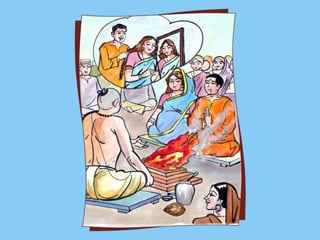 Simantonnayan (Parting the wife’s hair) -Third sanskar
Simantonnayan (Parting the wife’s hair) -Third sanskar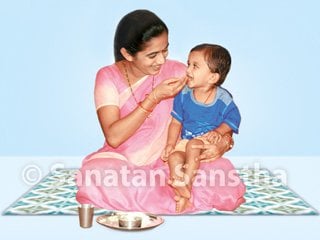 Sanskars performed after the birth of a child ! (Fourth, Fifth, Sixth and Seventh Sanskar)
Sanskars performed after the birth of a child ! (Fourth, Fifth, Sixth and Seventh Sanskar)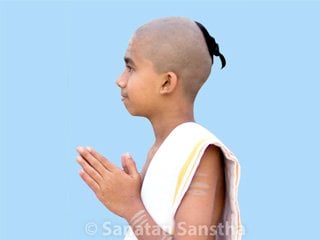 Choulkarma (Chudakarma) – keeping a shendi !
Choulkarma (Chudakarma) – keeping a shendi !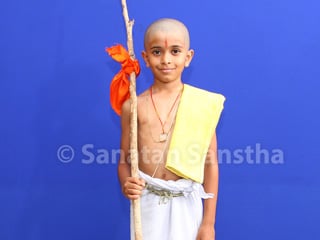 Upanayan (Vratabandha, Munja) – Ninth Sanskar
Upanayan (Vratabandha, Munja) – Ninth Sanskar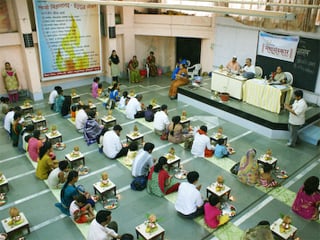 Medhajanan (Palsola vidhi)
Medhajanan (Palsola vidhi)